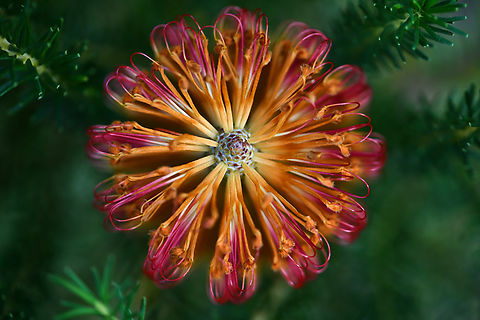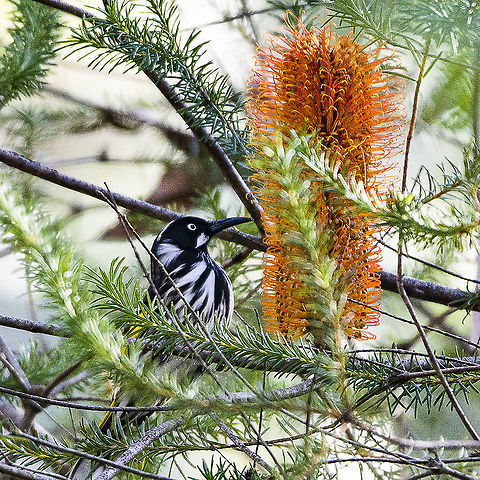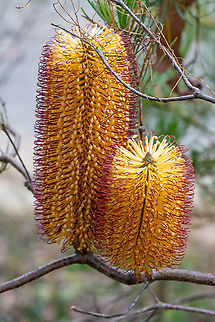
Appearance
Well known for its orange or red autumn inflorescences, which contrast with its green fine-leaved heath-like foliage, it is a medium to large shrub that can reach 6 m high and wide, though is usually half that size. In exposed heathlands and coastal areas it is more often 1–2 m.''Banksia ericifolia'' grows as a large shrub up to 6 metres in height, though often smaller, around 1–2 metres, in exposed places such as coastal or mountain heathlands. The grey-coloured bark is smooth and fairly thin with lenticels; however it can thicken significantly with age.
The linear dark green leaves are small and narrow, 9–20 mm long and up to 1 mm wide, generally with two small teeth at the tips. The leaves are crowded and alternately arranged on the branches. New growth generally occurs in summer and is an attractive lime green colour.
Flowering is in autumn, or in winter in cooler areas; the inflorescences are flower spikes 7–22 cm high and 5 cm broad or so. Each individual flower consists of a tubular perianth made up of four fused tepals, and one long wiry style.
Characteristic of the taxonomic section in which it is placed, the styles are hooked rather than straight. The styles' ends are initially trapped inside the upper perianth parts, but break free at anthesis, when the flowers open. The spikes are red or gold in overall colour, with styles golden, orange, orange-red or burgundy. Some unusual forms have striking red styles on a whitish perianth. Very occasionally, forms with all yellow inflorescences are seen. Though not terminal, the flower spikes are fairly prominently displayed emerging from the foliage; they arise from two- to three-year-old nodes.
Old flower spikes fade to brown and then grey with age; old flower parts soon fall, revealing numerous small dark grey to dull black finely furred follicles. Oblong in shape and 15–20 mm in diameter, the follicles are ridged on each valve and remain closed until burnt by fire. ''Banksia ericifolia'' responds to fire by seeding, the parent plant being killed.
As plants take several years to flower in the wild, it is very sensitive to too-frequent burns and has been eliminated in some areas where these occur. With time and the production of more cones with seed-containing follicles, however, plants can store up to 16,500 seeds at eight years of age. Some plants produce multiple flower spikes, possibly of varying sizes, from a single point of origin.

Naming
''Banksia ericifolia'' was one of the original ''Banksia'' species collected by Joseph Banks around Botany Bay in 1770 and was named by Carl Linnaeus the Younger, son of Carl Linnaeus, in 1782. A distinctive plant, it has split into two subspecies: ''Banksia ericifolia'' subspecies ''ericifolia'' of the Sydney region and ''Banksia ericifolia'' subspecies ''macrantha'' of the New South Wales Far North Coast which was recognized in 1996.
Distribution
In nature, the variety ''ericifolia'' is found on acidic sandstone-based soils; either in elevated heathland within 2 kilometres of the coast around the Sydney basin, from Collaroy south to Jervis Bay, or elevated sandstone soils in mountainous areas such as the Blue Mountains and the Budawangs.These heathlands are often moist, with access to some form of underground water, and can even be quite swampy. It can form dense thickets with the Dagger Hakea and Scrub She-oak. Other plants it associates with include the Coast Tea-tree and smaller plants such as ''Woollsia pungens''. The inflorescences are a feature of autumn bushwalking in sandstone areas, such as the Kings Tableland walk in the Blue Mountains, Jennifer Street Boardwalk in Little Bay, and Royal National Park.
The northern subspecies ''macrantha'' is found in two distinct regions on the far north coast of New South Wales; the first from Crowdy Bay on the Mid North Coast northwards to Hat Head National Park north of Port Macquarie, and then from Yuraygir National Park north to Kingscliff just south of the Queensland border. This variety is more strictly coastal with most populations being found within two kilometres of the coast, or in swampy areas. It may be associated with ''Banksia oblongifolia''.
References:
Some text fragments are auto parsed from Wikipedia.